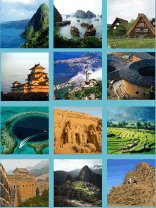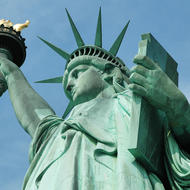Guide 8: Managing visitor behaviour
What this guide will tell you:
This guide will tell you why there is a need to manage visitor movements and behaviour, and how you may start to develop a visitor management system.
Steps to success:
- Why this matters
-
Managing visitor movements and influencing visitor behaviour are critical aspects of developing sustainable tourism. Not only is it often crucial to protecting the values and attributes of the World Heritage site, but it is also a contributing factor to a high quality visitor experience. By managing visitor flows, you can minimize the negative effects on the host community and maximize the opportunities for them to benefit.
There is a common misconception that visitor movements are beyond control, that they are simply a force of nature, but this is not the case. Great destinations manage where visitors go, when they go there, and what they do there. This is not about controlling or spoiling the visitors' experiences. In fact, it is exactly the opposite. Visitor management ensures that guests of the destination – now and in the future – can experience unspoiled and well-thought through attractions at well-preserved heritage sites.
-
 You cannot manage visitor behaviour unless you measure key variables first
You cannot manage visitor behaviour unless you measure key variables first -
Do your research – effective visitor management is basically impossible without some good analysis of the tourism that takes place. Most destinations and heritage sites are seasonal, so you need to identify when too many people may crowd the attractions, spoil the visitor experience, and damage the World Heritage site. Guide 1 (Understanding Tourism) should have helped you to identify the current and future demand for your destination. To manage visitor flows you need to be able to anticipate tourism demand based on past experiences. You cannot guess or estimate this. You must absolutely collect data to make demand forecasting effective. You also must be able to identify the time and physical spaces where the issues are arising and the key risks to the heritage.
1) Wider trends
Every destination is different, but being aware of the long-term and short-term trends with regard to visitor numbers and pressures is crucial. A destination that is subject to 20% growth per year in visitor numbers will need to develop visitor management systems appropriate for the pressures that are coming, as well as those that already exist. Forward forecasting – for example 5-10 years in advance – is critical.
2) Seasonality
Most destinations are subject to peak season pressures. In other words, the negative impacts and risks are not spread evenly across the year, and you need to identify the seasonal peaks and troughs. Visitor management systems must kick in and shape visitor movements and behaviours specifically during that period; in less busy periods it may not be necessary.
3) Monthly and daily analysis
The patterns of leisure time hours for any given society have a major impact on the pressures at World Heritage sites. In some countries, weekends are often the days that have the greatest visitor numbers, so it may be wise to identify this time period in advance and develop systems for managing visitor movements and behaviours on those peak days.
4) Public holidays and special days
In many societies, the greatest pressures will come on a handful of public or religious holidays, special days, or festivals, especially if the World Heritage site in question has a spiritual significance. Again, visitor management should identify and focus on these days in advance and develop an appropriate system of management.
5) Time of the day
It is vital to have some understanding of the peak periods during the day. Pressures will vary enormously, and improving the quality of visitor experience, mitigating pressures, and spreading benefits for the local community can often all be improved by spacing out visitor groups throughout the day.
-
 Some ways to gather this information
Some ways to gather this information -
- Ticket sales data
Some sites will simply be able to look at the data on ticket sales for the whole site or for key attractions to form an overview of visitor flows over the year, specific months, weeks, or days.
- Accommodation stock data
Some destinations will have accurate tourism data that reveal the densities of visitors at any point in the year.
- Observation
Working out when and where the issues are found at your site is not always high-tech and expensive. Sometimes simple observation of the issues can reveal a great deal of value.
- Surveying key people
Many sites overlook the expertise and observational skills of the people already on the ground. A simple survey that asks hoteliers, restaurateurs, conservationists, taxi drivers, guides, the host communities, and retailers when they experience peak periods can reveal a great deal about visitor movements.
- Enabling people to register their concerns in a low-tech way
For example, texting a number when they experience unacceptable impacts can also be valuable.
-
 Think carefully about the destination’s 'carrying capacity' or 'carrying capacity range' and the variables that affect its ability to accommodate people
Think carefully about the destination’s 'carrying capacity' or 'carrying capacity range' and the variables that affect its ability to accommodate people -
Nothing in this guidance should be read as encouraging sites to attract tourism if this is not in the interest of the World Heritage site or the host community. Some heritage is so sensitive to the impacts of visitors that it needs to be entirely protected and made accessible in other ways than physically experiencing the site (e.g. Altamira in Spain). Some World Heritage sites are working on models of 'remote access', with visitor centres at an appropriate distance from the site, or at an accessible location even further away. Given the emergence of new technologies, many sites should be looking at different ways for people to access, learn about, and experience their sites and OUV without actually needing to visit.
The idea of a single number identifying how many visitors a site can accommodate – its 'carrying capacity' – is problematic. Recent research has suggested that a better way to think about 'carrying capacity' is to look at the constraints upon numbers and the variables that are likely to make anything beyond a certain number of visitors unsustainable and socially, ecologically, economically, or culturally damaging.
This is unlikely to be one simple number; it is more likely to be a range variable to different times. For example, in the dry season a destination may have acute water resource concerns if more than ‘xx’ visitors are at the resort, but this might not be a problem in the wet season. At different times and in different contexts there will be – without good visitor management – too many visitors in the wrong places. This will result in negative impacts on the heritage, a reduction in the quality of local life, as well as a poorer visitor experience at the destination. If you have good data on tourism pressures across time and physical spaces, then you can have a plan and a system that kicks in when it needs it is necessary, rather than trying to manage costly, constant interventions that may not be required or can be avoided all together.
The number of people a destination or site can accommodate sustainably can be increased if they are managed more effectively with better and more sustainable facilities. One of the leading authorities on this subject, Kiran Consulting, has suggested a new term for destinations – a 'Carrying Plan' – which involves the process of identifying how many visitors the destination can handle, and how to manage the destination differently when that number is exceeded.
-
 Develop a Carrying Capacity Plan and approach
Develop a Carrying Capacity Plan and approach -
If you are a well resourced destination or heritage site, then you may be able to commission a specialist's technical guidance for this task (it can be complex and requires computer modelling of a range of variables). Some World Heritage sites have invested in guidance to develop their Carrying Plan and have developed new infrastructure to manage visitor flows more effectively. The most sophisticated computerised systems change visitor flows and dwell times as key variables change in real time. This might mean that guides take groups of visitors on a different route to see a different site to ease congestion at ‘honeypot’ sites, or that access to a sensitive area of the site is restricted when footfall reaches a certain level. Often such specialist guidance helps a destination to manage access to sensitive elements of the site – by developing new interpretation facilities before or after the sensitive elements to minimise dwell time at the most vulnerable points.
If you have very limited resources then you need to learn from the best examples and implement low-tech, low cost solutions. For instance, if your research tells you that national holidays are the most densely crowded days, then you can develop a system for those days that:
- Channels visitors across a wider area of the destination
- Restricts access to sensitive areas
- Raises prices for some areas of concern
- Limits them to timed tickets
There are a number of visitor management techniques that do not need to cost a great deal of money, but they do require you to clearly identify the timing and intensity of the issues, as well as where such special systems need to be implemented.
Remember, the destination is usually bigger than the World Heritage site – utilise the wider destination to spread both positive and negative impacts. Visitors will not be aware of the boundaries of the World Heritage site and tend to experience the whole place, so put non-essential activities elsewhere in the destination, rather than in the boundaries of the World Heritage site.
-
 Some methods to consider using for managing visitors
Some methods to consider using for managing visitors -
1) Limit visitor access
The crudest way to protect heritage from visitor impacts is to block access or severely limit it. Visitors do not have a ‘right’ to see a site if it simply cannot sustain the impacts of the visitation. If only a set number of people can access the site each hour or day, then make this clear through your interpretation and presentation of the site.
2) Spread visitors spatially and across time to minimize the intensity of negative impacts
You cannot let more and more visitors into delicate ecological or cultural settings without something going wrong, but you can ease the pressures by spreading tourism more evenly across the destination, by broadening the visitor offer and experiences, or by encouraging visitors to arrive at less pressured moments in the day, week, month, or year.
3) Advance ticketing systems
Some World Heritage sites now have ticket-only access. This kind of system enables a site to release only enough tickets for any given day. It also means they can offer a high quality visitor experience and protect the heritage from pressures. Tourism businesses may fear such measures as being perceived by visitors as a negative control, but the effect will be the opposite. Visitors will actually perceive the destination as more special, more authentic, and more unique. Some destinations will become a ‘once-in-a-lifetime’ destination, with visitors applying for tickets years in advance. Altamira in Spain and Puerto-Princesa Underground River Park in the Philippines are two instances where limiting entry has already proved to be very successful.
4) Congestion-related pricing systems
People often depend on incentives, and in many cases, raising the ticket price for sensitive areas of the site on peak congestion days will engineer a reduction in congestion. However, be warned that some unique experiences are perceived as more desirable if they cost more, and the desired effect could also be lost. Pricing can be a useful way to incentivize visitors to spread more evenly throughout the day or week. By offering much cheaper tickets for quiet periods and more expensive ones for peak periods, you can engineer a more even visitor flow and relieve the extreme peak pressures. Also communicate these concerns to visitors, as some will prefer to visit at less busy times anyway, especially if it helps to conserve the site.
5) Spreading visitors across the destination
The negative effects of tourism tend to be concentrated in specific places within the destination at the 'must see' aspects of the site. Great sites can avoid this by creating narratives and flows that channel visitors through a range of experiences and spaces, slowing their flow and increasing dwell time in non-vulnerable areas. For example, people viewing a sensitive element of the site can spend just a short time there if they are able to learn about it before or afterwards. They do not need all the interpretation in the immediate vicinity. It is also possible to widen the range of ‘must-see’ things through clever interpretation and storytelling. Telling a wider story of the host community and their culture, as well as the OUV also helps this.
6) Offer visitors other experiences, products, and services to lessen the urgency and focus on a small number of 'must see' elements
It is an important objective to increase visitor dwell-time where it does the least damage, and minimize dwell-time where it does the most. Broaden tourist scope by drawing their attention to lesser-known and less vulnerable areas of your destination.
-
 Give people the information they need to make good choices
Give people the information they need to make good choices -
Give visitors and tourism operators the real-time information they need to make good choices. Many visitors to a World Heritage site will already understand its susceptibility to damage or tourism pressures and will intend to act responsibly. Congestion or the other negative impacts of tourism can be communicated to visitors who are queuing or also at strategic points throughout their route. Many visitors will increase their dwell-time in less sensitive areas of the destination – shopping, eating, resting, learning, or simply taking in the ambience of the place – if they realise that pressing on regardless to the 'must see' element will create problems. Little things, such as having notices to tell people how long a queue will take to navigate, help enormously. You can simply write on the ground 'From here, this queue will take around 45 minutes. Why not go for coffee or explore X, Y, and Z?'
Develop a system for guides and other actors in tourism to make them aware of issues and solutions. People create problems, but people can also solve them if they have assistance and the resources to do so. If you can communicate to hotel receptionists, guides, taxi drivers, and others in the destination that on certain moments visitors should not be encouraged to rush to the 'must see' areas of the destination, in turn, these people can guide visitors to make different choices. For instance, they can suggest spending more time on a good meal, shopping, resting, seeing something else, etc.
-
 Increase dwell time where local businesses can secure benefit from visitors
Increase dwell time where local businesses can secure benefit from visitors -
Visitor flows can be designed so that the local community can secure the benefits. Some great sites have made visiting a local community to buy products, services, or experiences a key part of the visitor experience. This can often have the added advantage of taking place in a less sensitive location. People do not have to be sold things in the most vulnerable areas – retail can offered outside the sensitive zones to increase dwell-time there.


